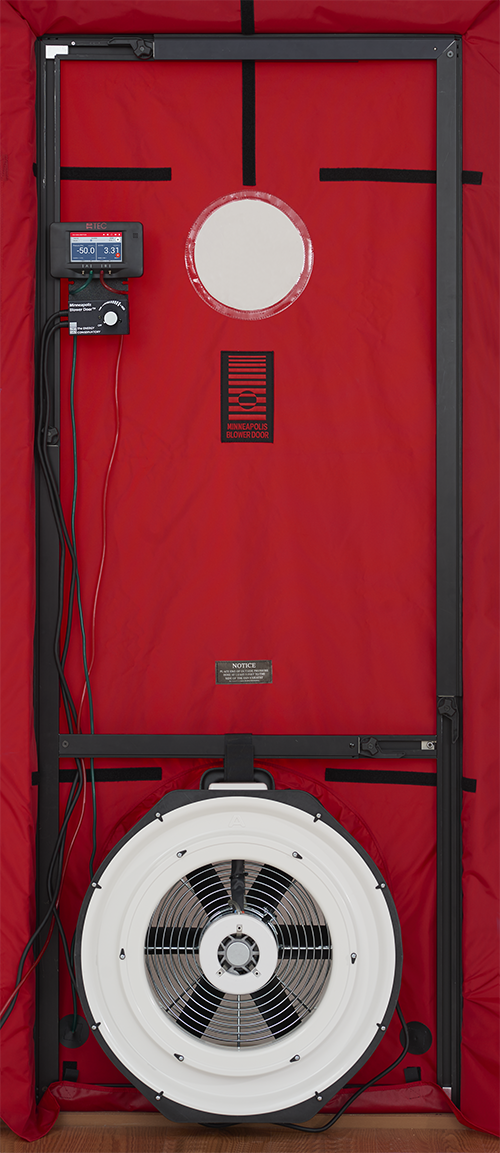|
Air Changes Per Hour
Air changes per hour, abbreviated ACPH or ACH, or air change rate is the number of times that the total air volume in a room or space is completely removed and replaced in an hour. If the air in the space is either uniform or perfectly mixed, air changes per hour is a measure of how many times the air within a defined space is replaced each hour. Perfectly mixed air refers to a theoretical condition where supply air is instantly and uniformly mixed with the air already present in a space, so that conditions such as age of air and concentration of pollutants are spatially uniform. In many air distribution arrangements, air is neither uniform nor perfectly mixed. The actual percentage of an enclosure's air which is exchanged in a period depends on the airflow efficiency of the enclosure and the methods used to ventilate it. These systems range from a conceptual system of perfect displacement, which removes and replaces all air in a space, to a short circuit flow in which very little o ... [...More Info...] [...Related Items...] OR: [Wikipedia] [Google] [Baidu] |
Volume
Volume is a measure of occupied three-dimensional space. It is often quantified numerically using SI derived units (such as the cubic metre and litre) or by various imperial or US customary units (such as the gallon, quart, cubic inch). The definition of length (cubed) is interrelated with volume. The volume of a container is generally understood to be the capacity of the container; i.e., the amount of fluid (gas or liquid) that the container could hold, rather than the amount of space the container itself displaces. In ancient times, volume is measured using similar-shaped natural containers and later on, standardized containers. Some simple three-dimensional shapes can have its volume easily calculated using arithmetic formulas. Volumes of more complicated shapes can be calculated with integral calculus if a formula exists for the shape's boundary. Zero-, one- and two-dimensional objects have no volume; in fourth and higher dimensions, an analogous concept to the normal vo ... [...More Info...] [...Related Items...] OR: [Wikipedia] [Google] [Baidu] |
Rules Of Thumb
In English, the phrase ''rule of thumb'' refers to an approximate method for doing something, based on practical experience rather than theory. This usage of the phrase can be traced back to the 17th century and has been associated with various trades where quantities were measured by comparison to the width or length of a thumb. A modern folk etymology holds that the phrase is derived from the maximum width of a stick allowed for wife-beating under English common law, but no such law ever existed. This belief may have originated in a rumored statement by 18th-century judge Sir Francis Buller that a man may beat his wife with a stick no wider than his thumb. The rumor produced numerous jokes and satirical cartoons at Buller's expense, but there is no record that he made such a statement. English jurist Sir William Blackstone wrote in his '' Commentaries on the Laws of England'' of an "old law" that once allowed "moderate" beatings by husbands, but he did not mention thumbs or ... [...More Info...] [...Related Items...] OR: [Wikipedia] [Google] [Baidu] |
Building Airtightness
Building airtightness (also called envelope airtightness) can be defined as the resistance to inward or outward air leakage through unintentional leakage points or areas in the building envelope. This air leakage is driven by differential pressures across the building envelope due to the combined effects of stack, external wind and mechanical ventilation systems. Airtightness is the fundamental building property that impacts infiltration and exfiltration (the uncontrolled inward and outward leakage of outdoor air through cracks, interstices or other unintentional openings of a building, caused by pressure effects of the wind and/or stack effect).M. Limb, "Technical note AIVC 36- Air Infiltration and Ventilation Glossary," International Energy Agency energy conservation in buildings and community systems programme, 1992 An airtight building has several positive impacts when combined with an appropriate ventilation system (whether natural, mechanical, or hybrid): * Lower heating bi ... [...More Info...] [...Related Items...] OR: [Wikipedia] [Google] [Baidu] |
Blower Door
A blower door is a machine used to measure the airtightness of buildings. It can also be used to measure airflow between building zones, to test ductwork airtightness and to help physically locate air leakage sites in the building envelope. There are three primary components to a blower door: (1) a calibrated, variable-speed blower or fan, capable of inducing a range of airflows sufficient to pressurize and depressurize a variety of building sizes, (2) a pressure measurement instrument, called a manometer, to simultaneously measure the pressure differential induced across the face of the fan and across the building envelope, as a result of fan airflow, and (3) a mounting system, used to mount the fan in a building opening, such as a door or a window. Air tightness testing is usually thought of in residential settings. It is becoming more common in commercial settings. The General Services Administration (GSA) requires testing of new US federal government buildings. A variety o ... [...More Info...] [...Related Items...] OR: [Wikipedia] [Google] [Baidu] |
Infiltration (HVAC)
Infiltration is the unintentional or accidental introduction of outside air into a building, typically through cracks in the building envelope and through use of doors for passage. Infiltration is sometimes called air leakage. The leakage of room air out of a building, intentionally or not, is called exfiltration. Infiltration is caused by wind, negative pressurization of the building, and by air buoyancy forces known commonly as the stack effect. Infiltration measures The infiltration rate is the volumetric flow rate of outside air into a building, typically in cubic feet per minute (CFM) or liters per second (LPS). The air exchange rate, (''I''), is the number of interior volume air changes that occur per hour, and has units of 1/h. The air exchange rate is also known as air changes per hour (''ACH''). ACH is the hourly ventilation rate, divided by the building volume. It can be calculated by multiplying the building's CFM by 60, and then dividing by the building volume. ... [...More Info...] [...Related Items...] OR: [Wikipedia] [Google] [Baidu] |
Passive House
"Passive house" (german: Passivhaus) is a voluntary standard for energy efficiency in a building, which reduces the building's ecological footprint. It results in ultra-low energy buildings that require little energy for space heating or cooling. A similar standard, MINERGIE-P, is used in Switzerland. The standard is not confined to residential properties; several office buildings, schools, kindergartens and a supermarket have also been constructed to the standard. The design is not an attachment or supplement to architectural design, but a design process that integrates with architectural design. Although it is generally applied to new buildings, it has also been used for refurbishments. In 2008, estimates of the number of passive house buildings around the world ranged from 15,000 to 20,000 structures. In 2016, there were approximately 60,000 such certified structures of all types worldwide. The vast majority of passive structures have been built in German-speaking countri ... [...More Info...] [...Related Items...] OR: [Wikipedia] [Google] [Baidu] |
Industrial Hygiene
Occupational hygiene (United States: industrial hygiene (IH)) is the anticipation, recognition, evaluation, control, and confirmation (ARECC) of protection from hazards at work that may result in injury, illness, or affect the well being of workers. These hazards or stressors are typically divided into the categories biological, chemical, physical, ergonomic and psychosocial. The risk of a health effect from a given stressor is a function of the hazard multiplied by the exposure to the individual or group. For chemicals, the hazard can be understood by the dose response profile most often based on toxicological studies or models. Occupational hygienists work closely with toxicologists (see Toxicology) for understanding chemical hazards, physicists (see Physics) for physical hazards, and physicians and microbiologists for biological hazards (see Microbiology Tropical medicine Infection). Environmental and occupational hygienists are considered experts in exposure science and ex ... [...More Info...] [...Related Items...] OR: [Wikipedia] [Google] [Baidu] |
Heating, Ventilation, And Air Conditioning
Heating, ventilation, and air conditioning (HVAC) is the use of various technologies to control the temperature, humidity, and purity of the air in an enclosed space. Its goal is to provide thermal comfort and acceptable indoor air quality. HVAC system design is a subdiscipline of mechanical engineering, based on the principles of thermodynamics, fluid mechanics, and heat transfer. "Refrigeration" is sometimes added to the field's abbreviation as HVAC&R or HVACR, or "ventilation" is dropped, as in HACR (as in the designation of HACR-rated circuit breakers). HVAC is an important part of residential structures such as single family homes, apartment buildings, hotels, and senior living facilities; medium to large industrial and office buildings such as skyscrapers and hospitals; vehicles such as cars, trains, airplanes, ships and submarines; and in marine environments, where safe and healthy building conditions are regulated with respect to temperature and humidity, using fresh ai ... [...More Info...] [...Related Items...] OR: [Wikipedia] [Google] [Baidu] |



